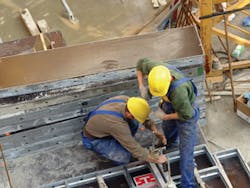Projected Construction Employment Numbers Not in Sync
One of the most intriguing empirical puzzles brought about by recent U.S. economic conditions is the apparent disconnect between measures of output and employment, says a study sponsored by Automatic Data Processing (ADP) and developed by Macroeconomic Advisers in July.
In “What's Up with Construction Employment?” Macroeconomic analysts point out that over the four quarters ended in the first quarter of 2007, real GDP advanced just 1.9%, a pace normally associated with a rising unemployment rate. Yet, the civilian unemployment rate has fallen from 4.8% in February 2006 to 4.5% in June of this year. In the spring of 2006, the six-month annualized percent change in establishment employment was 2.1%. By June of this year, it had slipped to 1.3%. In no industry does this disconnect seem more apparent than in construction.
Starts of private single-family homes, which peaked at 1,837,000 in January of 2006, have since plummeted 36% to 1,170,000 in May of this year. However, employment in the construction industry peaked at 7,725,000 last September and has fallen a mere 0.6%, to 7,681,000 in June. According to the report, this discrepancy has caught the attention of economists and financial analysts, many of whom anticipate an eventual large decline in construction employment, argue that there may already have occurred a substantial decline in the employment of undocumented workers (e.g., illegal immigrants) in the construction industry that has gone unreported to the Bureau of Labor Statistics (BLS), or suspect that the official statistics for employment in the construction industry are biased upward by a faulty “birth/death adjustment” applied by the BLS. If the recent birth/death adjustment is biased upward, Macroeconomic Advisers predicts there could be a downward revision to recent construction employment when, early next year, the BLS extends its annual benchmarking from March of 2006 to March of 2007. Such a revision might align construction employment better with other measures of real activity in the industry.
According to the BLS, employment in the construction industry remains near its most recent cyclical peak, despite major contractions in other measures of construction activity. A statistical modeling based on these official estimates suggests that by year's end construction employment could fall by approximately 250,000. However, previously unpublished data used to prepare the “ADP National Employment Report” suggest that it might already have dropped by approximately 160,000. According to Macroeconomic Advisers, the bottom line is the pending decline, which is expected to have run its course by the spring of 2008, should prove manageable for the construction industry.
